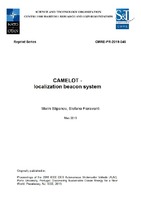| dc.contributor.author | Stipanov, Marin | |
| dc.contributor.author | Fioravanti, Stefano | |
| dc.date.accessioned | 2019-06-18T14:05:08Z | |
| dc.date.available | 2019-06-18T14:05:08Z | |
| dc.date.issued | 2019-05 | |
| dc.identifier.govdoc | CMRE-PR-2019-045 | en_US |
| dc.identifier.uri | http://hdl.handle.net/20.500.12489/785 | |
| dc.description.abstract | C2 Advanced Multi-Domain Environment And Live Observation Technologies (CAMELOT) is a H2020 project intended to develop and demonstrate different advanced command and control service modules for multiple platform domains customizable to the user needs. Currently, there is no widespread standard for multi-service, multidomain command and control (C2) systems. The CAMELOT architecture and modules will help build critical support in both the industrial and the practitioner communities leading to the adoption of these technologies. The underwater domain is a special case in command and control as communication and localization have to be implemented in a completely different way. The underwater domain is reached using one or many, mobile or stationary surface assets that act as gateways. The same assets provide underwater assets with positional updates. The localization beacon system (LBS) is a novel localization system being developed in the scope of the CAMELOT project. LBS provides assets with position data in a unidirectional way. The beacon is composed of a circular transducer array which signals vary in properties from one another thus allowing assets to hear a composite signal that varies depending on the bearing from the beacon. As the beacon can be mobile a parallel acoustic modem message is sent informing assets of the beacon pose and other relevant data. To keep the method unidirectional synchronized clocks are used for ranging thus allowing any listener to calculate its position using only a receiving hydrophone. As the underwater robotic world is growing and more and more multi-platform solutions are being proposed for various maritime missions and tasks, this LBS brings an advantage in comparison to classic underwater positioning systems as it provides a constant position update rate invariant to the number of assets. Assets are "linked" using an acoustic modem network allowing them to exchange data and inform the C2 station of their status. The JANUS acoustic modem standard is used to render the system in the spirit of the CAMELOT project. This paper presents the LBS concept using simulated signals and provides analysis of the expected accuracy for the later experiments. CAMELOT project has received funding from the European Union's Horizon 2020 research and innovation programme under grant agreement No 740736. | en_US |
| dc.language.iso | en | en_US |
| dc.publisher | CMRE | en_US |
| dc.subject | Acoustic beacons | en_US |
| dc.subject | CAMELOT (C2 Advanced Multi-Domain Environment And Live Observation Technologies) EU project | en_US |
| dc.subject | Command and control systems | en_US |
| dc.title | Camelot - localization beacon system | en_US |
